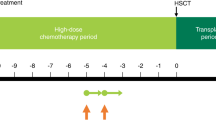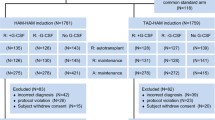Summary
Patients with malignant astrocytoma continue to respond poorly to chemotherapy and have a dismal prognosis. Cyclophosphamide (CTX) and etoposide demonstrate activity against malignant astrocytoma at standard dosages, with bone marrow suppression as the limiting toxicity. In order to allow dose intensification, minimize leukopenia, and improve efficacy granulocyte colony-stimulating factor (G-CSF) was used in combination with CTX and etoposide. The protocol consisted of CTX (2 mg/m2/d, days 1, 2), etoposide (200–300 mg/m2/d, days 1–3), and G-CSF (5–10 μg/d subcutaneously, days 4–18), every 4 weeks. Nine evaluable patients (7 glioblastoma multiforme, 2 anaplastic astrocytoma) were treated, ranging in age from 26–67 (mean 41). One of 9 patients responded (11%) with a partial response (13+ months), 3 had stable disease (33%; 8, 5, 2.5 months), and 5 had progressive disease (3, 2.5, 2, 1.5, 1 months). The median time to progression for responders was 6.5 months, while overall it was 2.5 months. Overall median survival was only 7.0 months. Toxicity was frequent and severe, typically delaying treatment cycles. The most common complications were severe myeolosuppression (9), sepsis (8), rash (6), urinary infection (5), and anorexia (5). Treatment delays caused by infections and other complications occurred often, abrogating the intended dose intensification. The received dose intensity (DI) for CTX was 400–425 mg/m2/week (relative DI 0.41), while for etoposide it was 75 mg/m2/ week (relative DI 0.42). In summary, as used in this protocol, dose intensive chemotherapy with CTX, etoposide, and G-CSF does not improve efficacy over standard regimens and results in excessive toxicity.
Similar content being viewed by others
References
Walker M, Alexander E, Hunt WE, MacCarty CS, Mahaley MS, Mealey J, Norrell HA, Owens G, Ransahoff J, Wilson CB, Gehan EA, Strike TA: Evaluation of BCNU and/or radiotherapy in the treatment of anaplastic glioma. J Neurosurg 49: 333–343, 1978
Walker M, Green SB, Byar DP, Alexander E, Batzdorf FU, Brooks WH, Hunt WE, MacCarty CS, Mahaley MS, Mealey J, Owens G, Ransahoff J, Robertson JT, Shapiro WR, Smith KR, Wilson CB, Strike TA: Randomized comparisons of radiotherapy and nitrosoureas for the treatment of malignant glioma after surgery. N Engl J Med 303: 1323–1329, 1980
Green SB, Byar DP, Walker MD, Pistenmaa DA, Alexander E, Batzdorf U, Brooks WH, Hunt WE, Mealey J, Odom GL, Paoletti P, Ransohoff J, Robertson JT, Selker RG, Shapiro WR, Smith KR, Wilson CB, Strike TA: Comparisons of carmustine, procarbazine, and high-dose methylprednisolone as additions to surgery and radiotherapy for the treatment of malignant glioma. Cancer Treat Rep 67: 121–132, 1983
Newton HB, Page MA, Junck L, Bromberg J, Greenberg HS: Procarbazine chemotherapy in the treatment of recurrent malignant astrocytomas after radiation and nitrosourea failure. Neurology 40: 1743–1746, 1990
Newton HB, Bromberg J, Junck L, Page MA, Greenberg HS: Comparison between BCNU and procarbazine chemotherapy for treatment of gliomas. J Neuro-Oncol 15: 257–263, 1993
Levin VA, Silver P, Hannigan J, Wara WM, Gutin PH, Davis RL, Wilson CB: Superiority of post-radiotherapy adjuvant chemotherapy with CCNU, procarbazine, and vincristine (PCV) over BCNU for anaplastic gliomas: NCOG 6G61 final report. Int J Rad Oncol Biol Phys 18: 321–324, 1990
Kornblith PL, Walker M: Chemotherapy for malignant gliomas. J Neurosurg 68: 1–17, 1988
Kyritsis AP: Chemotherapy for malignant gliomas. Oncology 7: 93–100, 1993
Hryniuk WM: Average relative dose intensity and the impact on design of clinical trials. Semin Oncol 14: 65–74, 1987
Hyrniuk WM: The importance of dose intensity in the outcome of chemotherapy. In: De Vita VT, Hellman S, Rosenberg SA (eds) Important Advances in Oncology 1988. J.B. Lippincott, Philadelphia, pp 121–142, 1988
Hryniuk W, Bush H: The importance of dose intensity in chemotherapy of metastatic breast cancer. J Clin Oncol 2: 1281–1288, 1984
Miller LL: Current status of G-CSF in support of chemotherapy and radiotherapy. Oncology 7: 67–83, 1993
Bronchud MH, Howell A, Crowther D, Hopwood P, Souza L, Dexter TM: The use of granulocyte colony-stimulating factor to increase the intensity of treatment with doxorubicin in patients with advanced breast and ovarian cancer. Br J Cancer 60: 121–125, 1989
Crawford J, Ozer H, Stoller R, Johnson D, Lyman G, Tabbara I, Kris M, Grous J, Picozzi V, Rausch G, Smith R, Gradishar W, Yahanda A, Vincent M, Stewart M, Giaspy J: Reduction by granulocyte colony-stimulating factor of fever and neutropenia induced by chemotherapy in patients with small-cell lung cancer. N Engl J Med 325: 164–170, 1991
Gabrilove JL, Jakubowski A, Scher H, Sternberg C, Wong G, Grous J, Yagoda A, Fain K, Moore MAS, Clarkson B, Oettgen HF, Alton K, Welte K, Souza L: Effect of granulocyte colony-stimulating factor on neutropenia and associated morbidity due to chemotherapy for transitional-cell carcinoma of the urothelium. N Engl J Med 318: 1414–1422, 1988
Yoshida T, Nakamura S, Ohtake S, Okafuji K, Kobayashi K, Kondo K, Kanno M, Matano S, Matsuda T, Kanai M, Sugimoto R, Ogawa M, Takaku F: Effect of granulocyte colony-stimulating factor on neutropenia due to chemotherapy for non-Hodgkin's lymphoma. Cancer 66: 1904–1909, 1990
Allen JC, Helson L: High-dose cyclophosphamide chemotherapy for recurrent CNS tumors in children. J Neurosurg 55:749–756, 1981
Longee DC, Friedman HS, Albright RE, Burger PC, Oakes WJ, Moore JO, Schold SC: Treatment of patients with recurrent gliomas with cyclophosphamide and vincristine. J Neurosurg 72: 583–588, 1990
Hellman RM, Calogero JA, Kaplan BM: VP-16, vincristine and procarbazine with radiation therapy for treatment of malignant brain tumors. J Neuro-Oncol 8: 163–166, 1990
Tirelli U, D'Incali M, Canetta R, Tumolo S, Franchin G, Veronesi A, Galligioni E, Trovo MG, Rossi C, Grigolitto E: Etoposide (VP-16-213) in malignant brain tumors: A phase II study. J Clin Oncol 2: 432–437, 1984
Daumas-Duport C, Scheithauer B, O'Fallon J, Kelly P: Grading of astrocytomas: a simple and reproducible method. Cancer 62: 2152–2165, 1988
National Cancer Institute: Common Toxicity Criteria. Bethesda, MD, NCI, 1988
Welte K, Bonilla MA, Gillio AP, Boone TC, Potter GK, Gabrilove JL, Moore MAS, O'Reilly RJ, Souza LM: Recombinant human granulocyte colony-stimulating factor. Effects on hematopoiesis in normal and cyclophosphamide-treated primates. J Exp Med 165: 941–948, 1987
Bronchud MH, Scarffe JH, Thatcher N, Crowther D, Souza LM, Alton NK, Testa NG, Dexter TM: Phase I/II study of recombinant human granulocyte colony-stimulating factor in patients receiving intensive chemotherapy for small cell lung cancer. Br J Cancer 56: 809–813, 1987
Neidhart J, Mangalik A, Kohler W, Stidley C, Saiki J, Duncan P, Souza L, Downing M: Granulocyte colony-stimulating factor stimulates recovery of granulocytes in patients receiving dose-intensive chemotherapy without bone marrow transplantation. J Clin Oncol 7: 1685–1692, 1989
Schold SC, Friedman HS, Bigner DD: Therapeutic profile of the human glioma line D-54 MG in athymic mice. Cancer Treat Rep 71: 849–850, 1987
Miser J, Krailo M, Smithson W, Belasco J, Ortega J, Hammond GD: Treatment of children with recurrent brain tumors with ifosfamide (IFOS), etoposide (VP16) and MESNA (M). Results of a phase II trial (abstract). Proceed ASCO 8: 84, 1989
Wiernick PH: The management of infections in the cancer patient. J Am Med Assoc 244: 185–187, 1980
Author information
Authors and Affiliations
Rights and permissions
About this article
Cite this article
Newton, H.B., Newton, C.L. Attempted dose intensified cyclophosphamide, etoposide, and granulocyte colony-stimulating factor for treatment of malignant astrocytoma. J Neuro-Oncol 24, 285–292 (1995). https://doi.org/10.1007/BF01052845
Issue Date:
DOI: https://doi.org/10.1007/BF01052845




